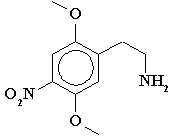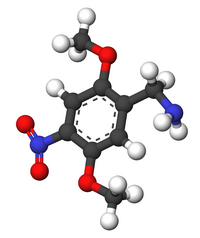{
Assessment |
Biopsychology |
Comparative |
Cognitive |
Developmental |
Language |
Individual differences |
Personality |
Philosophy |
Social |
Methods |
Statistics |
Clinical |
Educational |
Industrial |
Professional items |
World psychology |
Biological: Behavioural genetics · Evolutionary psychology · Neuroanatomy · Neurochemistry · Neuroendocrinology · Neuroscience · Psychoneuroimmunology · Physiological Psychology · Psychopharmacology (Index, Outline)

Chemical structure of 2C-N
2C-N, or 4-nitro-2,5-dimethoxyphenethylamine, is a psychedelic phenethylamine of the 2C family. It was first synthesized by Alexander Shulgin, sometimes used as an entheogen.
Chemistry[]

The full name of the chemical is 2-(2,5-dimethoxy-4-nitrophenyl)ethanamine.
Appearance[]
Salts of 2C-N has a bright yellow to orange color due to the presence of the nitro group, unlike all other members of the 2C family in which the salts are white.
Chemical appearance of 2C-N hcl
Dosage[]
In his book PiHKAL (Phenethylamines I Have Known and Loved), Shulgin lists the dosage range as 100-150 mg. 2C-N is generally taken orally, and effects typically last 4 to 6 hours.
Dangers[]
There have been no reported deaths or hospitalizations from 2C-N, but its safety profile is unknown.
Law[]
2C-N is unscheduled and uncontrolled in the United States, but possession and sales of 2C-N may potentially be prosecuted under the Federal Analog Act because of its structural similarities to 2C-T-7 or 2C-B. The legality of 2C-N is under scrutiny as of July 2004, due to Operation Web Tryp.
2C-N and all other compounds featuring in PiHKAL are illegal drugs in the United Kingdom.
External links[]
Psychedelic phenethylamines
| |
|---|---|
Aleph • 2C-B • 2C-B-FLY • 2C-C • 2C-D • 2C-E • 2C-F • 2C-G • 2C-I • 2C-N • 2C-O • 2C-O-4 • 2C-P • 2C-T • 2C-T-2 • 2C-T-4 • 2C-T-7 • 2C-T-8 • 2C-T-9 • 2C-T-13 • 2C-T-15 • 2C-T-17 • 2C-T-21 • 2C-TFM • 3C-E • 3C-P • Br-DFLY • DESOXY • DMMDA-2 • DOB • DOC • DOET • DOI • DOM • DON • Escaline • Ganesha • HOT-2 • HOT-7 • HOT-17 • Isoproscaline • Lophophine • MDA • MMDA • MMDA-2 • MMDA-3a • MMDMA • Macromerine • Mescaline • Proscaline • TMA |
.
| This page uses Creative Commons Licensed content from Wikipedia (view authors). |